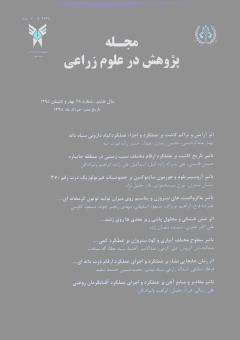اثر زمان جابجایی نشاء برعملکرد واجزای عملکرد ارقام ذرت دانه¬ای در کرمانشاه
محورهای موضوعی : توليد محصولات زراعي
1 - استادیار اصلاح نباتات، بخش تحقیقات زراعی و باغی، مرکز تحقیقات و آموزش گشاورزی و منابع طبیعی کرمانشاه، سازمان تحقیقات، آموزش و ترویج کشاورزی، کرمانشاه.، ایران.
کلید واژه: : ذرت دانه¬ای, عملکرد دانه, نشاء¬کاری, رقم,
چکیده مقاله :
به¬منظور کاهش مصرف آب در مزارع ذرت دانه¬ای، افزایش تولید و حفظ سطح زیرکشت ذرت، این پروژه به-صورت کرت¬های خردشده بر پایه طرح بلوک¬های کامل تصادفی در ایستگاه ماهیدشت در سال 1396 انجام شد. کرت¬های اصلی شامل ارقام KSC 260، KSC 400 و KSC 704 و کرت¬های فرعی نیز نشاء¬های با طول عمر دو، سه، چهار و پنج هفته همراه با کشت مستقیم بذر ارقام یاد شده بود. صفات زراعی ارتفاع بوته و بلال، قطرساقه، تعداد روز تا ظهور دانه گرده و گل ابريشمي، تعداد روز تا رسیدن فیزیولوژی، تعداد رديف دانه و دانه در رديف بلال، وزن هزار دانه، درصد چوب بلال، رطوبت دانه و عملكرد دانه اندازه¬گیری و برآورد شدند. نتایج نشان داد که بیشترین عملکرد دانه به هیبریدهای KSC 704 و KSC 400 به¬ترتیب برابر با 10330 و 9506 کیلوگرم در هکتار تعلق گرفت. رقم زودرس KSC 260با 7784 کیلوگرم در هکتار کمترین تولید دانه را داشت. متوسط عملکرد ارقام برای نشاءهای با سن سه هفته یا 21 روزه برابر با 3/8 تن در هکتار بود. بیشترین محصول دانه به تیمار KSC 704 در زمان انتقال دو هفته¬ای ذرت با عملکرد دانه 11640 کیلوگرم در هکتار تعلق گرفت. کمترین عملکرد دانه نیز به سه رقم مورد بررسی در زمان انتقال نشاءها با سن پنج هفته¬ای با 6597 کیلوگرم در هکتار تعلق گرفت. مناسب¬ترین زمان انتقال نشاء ذرت، نشاء¬های با طول عمر سه هفته¬ یا 21 روزه که از10 روز زودرسی و بیشترین عملکرد دانه برخوردار بودند.
To reduce water consumption in corn fields, and increase production and maintain the corn crop area of the province, a project was conducted as split-plot design based on randomized complete block design with three replications. The main plots consisted of cultivars and subplots in different times on transplantation with direct seed culture of these cultivars. Agronomic traits were measured including plant height, ear height, stem diameter, number of days to emergence of pollen and silk tasseled , number of days to reaching physiology, number of rows of seeds and seeds per row, 1000 seed weight, ear weight, grain moisture content and grain yield. The results showed that the grain yield of KSC 704 and KSC 400 was 10330 and 9506, respectively, and the yield of KSC 260 was 7784 kg / ha. The highest grain yield was obtained from KSC 704, the two-week of transplanting corn seedling with 11640 kg/ha-1 . The average yield of cultivars × five weeks of seedling transplantation with 6597 kg/ ha -1 , which showed the most suitable transfer time of maize transplant was 3 weeks age or 21 days, which were 10 days earlier and had the highest grain yield and therefore are recommended.
Anonymous. 2016. Information Center of Kermanshah Jihad Agriculture Organization.
Anonymous. 2016. Center for Statistics and Information Ministry of Agriculture.
Badran, M. S. S. 2001. Effect of transplanting and seedling age ongrain yield and its components of some maize cultivars. Alexandria Journal of Agricultural Research. 46(2): 47–56.
Basu, S., S. P. Sharma and S. Basu. 2003. Effect of transplanting on vegetative, floral and seed characters of maize (Zea mays L.) parental lines in spring-summer season. Indian Journal of Agricultural Sciences 73(1): 44-48
Biswas, M. 2008. Effect of Seedling Age and Variety on the Yield and Yield Attributes of Transplanted Maize. International Journal of Sustainable Crop Production. 3(6):58-63.
Biswas, M., N. Islam, , S. Islam and M. Ahmed. 2009. Seedling raising method for production of transplanted maize. International Journal of Sustainable Crop Production. 4(2): 6–3
Begna, SH., DL. Smith, RI. Hamilton, LM. Dwyer and DW. Stewart. 2001. Corn genotypic variation effects on seedling emergence and leaf appearance for short-season areas. Journal ofAgronomy and Crop Science. 186(4):267-271.
Dale, AE. and SH. Drennan. 1997. Transplanted maize (Zea mays L.) for grain production in southern England. I. Effects of planting date, transplant age at planting and cultivar on grain yield. Journal of Agricultural Sciences. 128(1):27-35.
Di Benedetto, A. and J. Rattin. 2008. Transplant in sweet maize: a tool for improving productivity. The Americas Journal of Plant Science and Biotechnology. 2(2):96-108.
Fanadzo, M., S. Chiduzaand and P. N. Mnkeni. 2010. Comparative response of direct seeded and transplanted maize to nitrogen fertilization at Zanyokwe Irrigation Scheme, Eastern Cape, South Africa. African Journal of Agricultural Research. 4 (8):689-694
Ghias-Abadi, M., M. Khajeh-Hosseini and A.A. Mohammad-Abadi. 2014. Effects of transplanting date on growth and yield of forage maizen (Zea mays L.) in Mashhad. Iranian Journal of Field Crops Research 12(1): 137-145. (In Persian with English Abstract)..
Khehra, A. S., H. S. Brar, R. K. Sharma, B. S. Dhillon and V. V. Malhotra. 1990. Transplanting maize during the winter in India. Agronomy Journal. 82: 41-47.
Liu, W., M. Tollenaar, G. Stewart and W. Deen. 2004. Response of corn grain yield to spatial and temporal variability in emergence. Crop Science. 44(3):847-854.
Liu, W., M. Tollenaar, G. Stewart and W. Deen. 2002. Within-row plant spacing variability does not affect corn yield. Agronomy journal. 96(1):275-280.
Bavec F, Bavec M. 2002. Effects of plant population on leaf area index, cob characteristics and grain yield of early maturing maize cultivars (FAO 100-400). European Journal of Agronomy. 16(2):151-159.
Oswald, A., J. K. Ransom, J. Kroschel and J. Sauerborn. 2001. Transplanting maize (Zea mays) and sorghum (Sorghum bicolor) reduces Striga hermonthica damage. Weed Sciences. 49: 346-353.
Rattin, J., A. Di Benedetto and T. Gornatti. 2006. The effect of transplant in sweet maize (Zea mays L.). I: Growth and Yield. International Journal of Agricultural Research.1(1):58-67.
Rattin, J., J.P. Valinote, R. Gonzalo and A. Di Benedetto. 2015. Transplant and change in plant density improve sweet maize (Zea mays L.) yield. American Journal of Experimental Agriculture. 5(4): 336-351.
Sanchez Andonova, P., J. Rattin and A. Di Benedetto. 2014. Yield increase as influence by transplanting of sweet corn (Zea mays L. saccharata). American Journal of Experimental Agriculture. 4(11): 1314-1329.
Sadeghi, F. 2017. Final report on the study of Effect of transplanting time on yield and yield of corn. Kermanshah Agricultural and Natural Resources Research and Education Center. 35 pages.
Sanjeev, K., K. Shivani and K. Santosh. 2014. Performance of transplanted maize (Zea mays L.) under varying age of seedling and method of nursery raising in the midlands of eastern regionIndian Journal of Agricultural Sciences. 84(7): 87–94.
Sharma, RK., HS. Brar, AS. Khehra and BS. Dhillon. 1989. Gap filling through transplanting in maize during winter. Journal ofAgronomy and Crop Science.162(3):145-148.
Vantine, M., and S. Verlinden. 2003. Growing organic vegetable transplants. West verginia university.
Welbaum, GE., J.M. Frantz, MK. Gunatilaka and Z. Shen. 2001. A comparison of the growth, establishment, and maturity of direct-seeded and transplanted sh2 sweet corn. Horticultural Science. 36(4):687-690.
Wyatt, J. E. and J. A. Mullins. 1988. Transplanted sweet corn. Hort. Sci. 23 (5): 824. In: Paper presented at American Society of Horticultural Science Southern Region 48th Annual Meeting. 31 Jan.-2 Feb., 1988, New Orleans, Louisiana.

